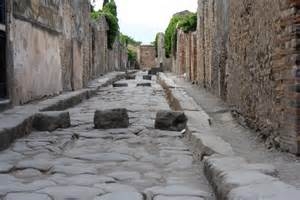
As you wander around Pompeii,it is strange to think that you are walking along the same pavements and streets as people did over 2000 years ago. The roads are paved with slabs of grey,volcanic rock from Vesuvius - just like the streets of nearby Naples today.
當(dāng)你在龐貝城漫步,你會(huì)吃驚地想到這是走在2000多年前的人們修建的街道上。街面鋪者灰色的平板磚、維蘇威火山的火山巖——就像今天那不勒斯附近的街面一樣。
The pavements were a lot higher than the level of road - for a very good reason. Not only did the road act asa drain for rainwater,but it also carried away a lot of rubbish and even sewage. This made it rather unpleasant to cross,so there were stepping stones to help people keep their feet clean.
人行道比街道的水平面稍微高一些——的確有理由做成這樣。不僅使馬路成為雨水的排水溝,而且?guī)ё吡嗽S多垃圾甚至是污水。這樣設(shè)計(jì)就使得橫穿馬路成為一件不讓人愉快的事情,所以馬路中間還有分級(jí)的石階以幫助人們保持腳的干凈。
The stepping stones were arranged with gaps so that the wheels of carts could pass through. We know that the streets of Pompeii carried a lot of wheeled traffic,because there are deep grooves where the wheels have worn away.
分級(jí)的石階鋪設(shè)得有間隙,這樣大車的輪子就能通過了。我們知道龐貝城的街道承載了大量輪運(yùn)交通,因?yàn)樵谀切┸囕喴呀?jīng)消逝的今天,它們深深的車轍還保留著。











